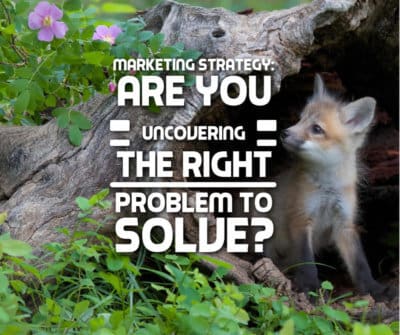 Consider this common business situation. The past two quarters’ profitability numbers came in far lower than projected. Management is called into a boardroom for a special marketing strategy huddle. The question on the whiteboard is: “What are three products we can introduce in the next 30 days to increase profits by 20%?” Managers accept this challenge enthusiastically and a few volunteers leap up to start a bullet-pointed list of all the ideas. The last two hours of the day are spent examining the list and figuring out which three can feasibly be implemented within 30 days. Finally, managers are assigned to committees that will create implementation plans and report back in a few weeks. Been there?
Consider this common business situation. The past two quarters’ profitability numbers came in far lower than projected. Management is called into a boardroom for a special marketing strategy huddle. The question on the whiteboard is: “What are three products we can introduce in the next 30 days to increase profits by 20%?” Managers accept this challenge enthusiastically and a few volunteers leap up to start a bullet-pointed list of all the ideas. The last two hours of the day are spent examining the list and figuring out which three can feasibly be implemented within 30 days. Finally, managers are assigned to committees that will create implementation plans and report back in a few weeks. Been there?
Unfortunately, this process typically ends in frustration. Product development teams race to meet deadlines without a good vision for what the end goal is. Marketing teams write scripts to convince customers these new products are valuable. Sales teams hustle to try to make their quotas. Consumers can become confused or overwhelmed with new choices. It’s just not efficient. In short – there was no marketing strategy.
The process for operating a business is simple. Businesses provide products and/or services that consumers need, consumers purchase them and receive the benefits, and businesses benefit via the profit margin. There are two ways businesses can achieve this:
- Identify the needs of a segment of consumers and design a solution the company can build or provide at a cost less than the value it brings to buyers (in other words, it can be sold at a profit.)
- Identify a product or service the company can provide at a low cost and convince consumers they need it and should pay a premium for it.
Which business do you want to be in?
The most successful small to medium size businesses use the first strategy—they start by identifying a problem they can solve for their consumers. Businesses exist to be societal problem solvers.
Too many times, we put the product first and then try to develop a need for it later. Entrepreneurs often come up with really creative designs for a new product but become disappointed when the inventory doesn’t sell. In the conquest to achieve greater sales, small and medium-size businesses might look to see what’s selling in the marketplace, but later find out the initial excitement phase has passed for the consumer and the market is more than saturated.
Instead, try starting your brainstorming meetings with questions like:
- What challenges are our customers dealing with right now?
- What is a problem our customers have that we can solve for them?
- What is something our customers have to do that we can make easier or simpler for them?
- What types of services have our customers asked us for that we don’t provide already?
- What consumes our customers’ time that we can shorten or eliminate with our technology?
See how these questions start with the customer and then consider how the business can serve them? Regardless of your industry, your business has skills, creativity, and strengths to make your customers’ lives easier, simpler, and more comfortable. The key is to start by identifying the problem (or challenge, struggle, obstacle, etc.) first, and then create the right solution.
Better Marketing Strategy: How do you identify the problem?
Before you can solve a problem, you need to fully understand it—and that means finding the root cause. Otherwise, even if a problem is apparent, the proposed solution may be completely off the mark.
For example, Proctor and Gamble spent years trying to come up with a better floor-cleaning product to increase sales. It makes sense—if people want an easier way to clean the floors, improve the chemical formula. Nothing seemed to work as formulas with stronger cleaning power stripped the finish off the floors. Finally, in the mid-’90s, a keen observer noticed that making floors easier to clean didn’t necessarily mean improving the formula—it meant eliminating the painstaking and disgusting process to clean the mop afterward. After experimenting with prototypes and focus groups, the Swiffer was born. P&G learned that the real problem was mop maintenance, and the right solution was to provide a lightweight disposable cleaning head. Consumers loved it and sales shot through the roof.
There are a number of ways to conduct root cause analysis:
- Ask the 5 Why’s. Lean manufacturing has evolved into process improvement strategies for every type of business. Asking a series of “why” questions help to go beyond surface-level assumptions to uncover root causes.
- Drawing flow charts to illustrate processes can help identify weak points or failures that cause problems to occur. To be most effective, people involved in the process should be used to build the flowcharts.
- Cause & Effect Diagrams. This method addresses the “6 M’s”: methods, machines, manpower, mother nature, measurement, and materials to discover what causes and effects each “M” is responsible for in creating the problem.
Want to change how your company innovates?
Connect with us at Paradux Media Group. We can help your business strategize differently and look at business opportunities and your marketing strategy through new lenses. Our team is equipped to help you and your leaders build business plans, create a marketing strategy, rework branding, evaluate e-channels, and provide other support to help you achieve your goals and reach success. Call us today to learn more about the benefits of joining our flock.
- Published: March 22, 2021
- Author: Angela Peacor
- Blog: Marketing Intelligence Report
- Category:
- Tags:
- Comments:
Quacktastic Reviews:
Excellent team to work with! Mike and Tisha are fantastic at coming up with new ideas while staying true to my companies vision, values, and…

Operating a restaurant and bar is hard enough. It demands wearing many hats. Promotions and marketing is not one of them any longer since we…











Can not recommend this team enough. What started as a one-time website re-design has evolved into Paradux handling the vast majority of our marketing. Business…











We would not be able to run as smoothing, quickly, or efficiently if it was not for Paradux Media Group. Tisha and team is hands…











Recently, I had the opportunity to work with Paradux Media on a website build, and I just couldn’t have been happier with the process and…











Mike and his team are well known within the region and marketing community as an insightful industry leader. If you are looking for a Marketing…











Paradux Media is a very professional group, and they know what they’re doing. Whether they are placing buys for clients, or producing high-quality TV spots,…











Paradux helped build my business in all capacities. Without them, I would never have had the resources and ability to get so much accomplished –…











Mike, Tisha, and the team can build you anything you want for your company or small business. Very knowledgeable and easy to work with. They…











As a long-time client of Paradux, I can confidently say that their creative team is one of the best in the business. They consistently produce…





















